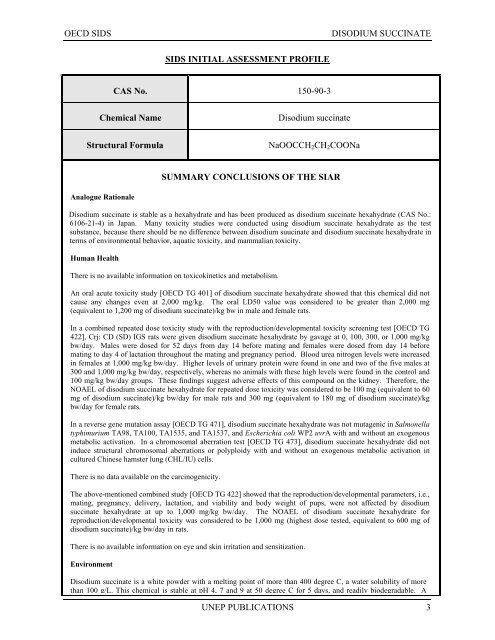DISODIUM SUCCINATE CAS N°: 150-90-3
DISODIUM SUCCINATE CAS N°: 150-90-3
DISODIUM SUCCINATE CAS N°: 150-90-3
You also want an ePaper? Increase the reach of your titles
YUMPU automatically turns print PDFs into web optimized ePapers that Google loves.
OECD SIDS<br />
<strong>DISODIUM</strong> <strong>SUCCINATE</strong><br />
SIDS INITIAL ASSESSMENT PROFILE<br />
<strong>CAS</strong> No. <strong>150</strong>-<strong>90</strong>-3<br />
Chemical Name<br />
Disodium succinate<br />
Structural Formula<br />
NaOOCCH 2 CH 2 COONa<br />
SUMMARY CONCLUSIONS OF THE SIAR<br />
Analogue Rationale<br />
Disodium succinate is stable as a hexahydrate and has been produced as disodium succinate hexahydrate (<strong>CAS</strong> No.:<br />
6106-21-4) in Japan. Many toxicity studies were conducted using disodium succinate hexahydrate as the test<br />
substance, because there should be no difference between disodium suucinate and disodium succinate hexahydrate in<br />
terms of environmental behavior, aquatic toxicity, and mammalian toxicity.<br />
Human Health<br />
There is no available information on toxicokinetics and metabolism.<br />
An oral acute toxicity study [OECD TG 401] of disodium succinate hexahydrate showed that this chemical did not<br />
cause any changes even at 2,000 mg/kg. The oral LD50 value was considered to be greater than 2,000 mg<br />
(equivalent to 1,200 mg of disodium succinate)/kg bw in male and female rats.<br />
In a combined repeated dose toxicity study with the reproduction/developmental toxicity screening test [OECD TG<br />
422], Crj: CD (SD) IGS rats were given disodium succinate hexahydrate by gavage at 0, 100, 300, or 1,000 mg/kg<br />
bw/day. Males were dosed for 52 days from day 14 before mating and females were dosed from day 14 before<br />
mating to day 4 of lactation throughout the mating and pregnancy period. Blood urea nitrogen levels were increased<br />
in females at 1,000 mg/kg bw/day. Higher levels of urinary protein were found in one and two of the five males at<br />
300 and 1,000 mg/kg bw/day, respectively, whereas no animals with these high levels were found in the control and<br />
100 mg/kg bw/day groups. These findings suggest adverse effects of this compound on the kidney. Therefore, the<br />
NOAEL of disodium succinate hexahydrate for repeated dose toxicity was considered to be 100 mg (equivalent to 60<br />
mg of disodium succinate)/kg bw/day for male rats and 300 mg (equivalent to 180 mg of disodium succinate)/kg<br />
bw/day for female rats.<br />
In a reverse gene mutation assay [OECD TG 471], disodium succinate hexahydrate was not mutagenic in Salmonella<br />
typhimurium TA98, TA100, TA1535, and TA1537, and Escherichia coli WP2 uvrA with and without an exogenous<br />
metabolic activation. In a chromosomal aberration test [OECD TG 473], disodium succinate hexahydrate did not<br />
induce structural chromosomal aberrations or polyploidy with and without an exogenous metabolic activation in<br />
cultured Chinese hamster lung (CHL/IU) cells.<br />
There is no data available on the carcinogenicity.<br />
The above-mentioned combined study [OECD TG 422] showed that the reproduction/developmental parameters, i.e.,<br />
mating, pregnancy, delivery, lactation, and viability and body weight of pups, were not affected by disodium<br />
succinate hexahydrate at up to 1,000 mg/kg bw/day. The NOAEL of disodium succinate hexahydrate for<br />
reproduction/developmental toxicity was considered to be 1,000 mg (highest dose tested, equivalent to 600 mg of<br />
disodium succinate)/kg bw/day in rats.<br />
There is no available information on eye and skin irritation and sensitization.<br />
Environment<br />
Disodium succinate is a white powder with a melting point of more than 400 degree C, a water solubility of more<br />
than 100 g/L. This chemical is stable atpH 4, 7and 9 at 50 degree C for 5days,and readily biodegradable. A<br />
UNEP PUBLICATIONS 3
















